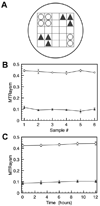High-throughput screening of chemical exchange saturation transfer MR contrast agents
- PMID: 20586030
- PMCID: PMC2898906
- DOI: 10.1002/cmmi.383
High-throughput screening of chemical exchange saturation transfer MR contrast agents
Abstract
A new high-throughput MRI method for screening chemical exchange saturation transfer (CEST) agents is demonstrated, allowing simultaneous testing of multiple samples with minimal attention to sample configuration and shimming of the main magnetic field (B(0)). This approach, which is applicable to diamagnetic, paramagnetic and liposome CEST agents, employs a set of inexpensive glass or plastic capillary tubes containing CEST agents put together in a cheap plastic tube holder, without the need for liquid between the tubes to reduce magnetic susceptibility effects. In this setup, a reference image of direct water saturation spectra is acquired in order to map the absolute water frequency for each volume element (voxel) in the sample image, followed by an image of saturation transfer spectra to determine the CEST properties. Even though the field over the total sample is very inhomogeneous due to air-tube interfaces, the shape of the direct saturation spectra is not affected, allowing removal of susceptibility shift effects from the CEST data by using the absolute water frequencies from the reference map. As a result, quantitative information such as the mean CEST intensity for each sample can be extracted for multiple CEST agents at once. As an initial application, we demonstrate rapid screening of a library of 16 polypeptides for their CEST properties, but in principle the number of tubes is limited only by the available signal-noise-ratio, field of view and gradient strength for imaging.
Figures





References
-
- Ward KM, Aletras AH, Balaban RS. A new class of contrast agents for MRI based on proton chemical exchange dependent saturation transfer (CEST) Journal of Magnetic Resonance. 2000;143(1):79–87. - PubMed
-
- Zhou J, van Zijl PC. Chemical exchange saturation transfer imaging and spectroscopy. Progress in Nuclear Magnetic Resonance Spectroscopy. 2006;48:109–136.
-
- Aime S, Barge A, Delli Castelli D, Fedeli F, Mortillaro A, Nielsen FU, Terreno E. Paramagnetic lanthanide(III) complexes as pH-sensitive chemical exchange saturation transfer (CEST) contrast agents for MRI applications. Magnetic Resonance in Medicine. 2002;47(4):639–648. - PubMed
-
- Vinogradov E, He H, Lubag A, Balschi JA, Sherry AD, Lenkinski RE. MRI detection of paramagnetic chemical exchange effects in mice kidneys in vivo. Magnetic Resonance in Medicine. 2007;58(4):650–655. - PubMed
Publication types
MeSH terms
Substances
Grants and funding
LinkOut - more resources
Full Text Sources
Other Literature Sources
Medical
Research Materials
